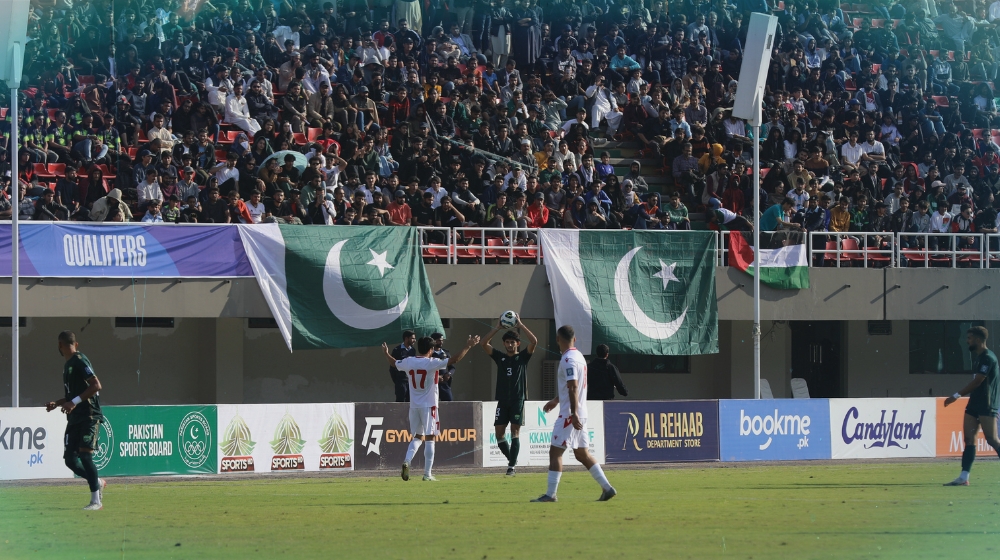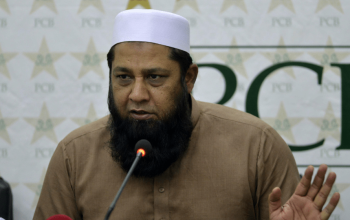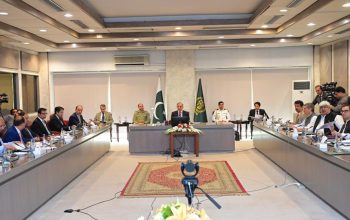There has been a lot of noise recently within sports circles in Pakistan about starting a football league based on a franchise system similar to the Pakistan Super League (PSL) and help grow the game both commercially and in sporting terms. The PSL stands out as an example of how to capture the interest of the country and provide an avenue for much-needed entertainment, whilst developing a professional sports business culture that had been missing prior to this.
The PSL’s business model is based on the success of the Indian Premier League (IPL), which itself charges ‘franchise’ or ‘participation fees’ from the teams themselves. Owners do not own the sports team outright, but are dependent on paying hefty sums to the league to continue playing.
But for cricket, this has sparked a revolution unlike any other. The IPL has become a global phenomenon and just the top line numbers paint an unbelievable picture. The brand value has skyrocketed to over $11 billion in 2022, the media rights for the last cycle were sold for $6.4 billion to ViaCom18 and Star Sports while Tata pays $60.2 million per year as the title sponsor.
The influx of cash is clearly reflected in the growth of IPL clubs, whose average revenue in the Financial Year (FY) 2023 stands at $36 million. Building on this success, a number of sports leagues were launched ranging from Kabaddi to Hockey. However, a keen focus has been football, which is the world’s biggest game and a sport in which India does not boast noteworthy accolades.
Kolkata Knight Riders (KKR) winning the 2024 IPL (Sky Sports)
However, the Indian Super League (ISL)’s conception was different from the IPL. For starters, the rights to the league itself was acquired by Reliance Industries for approximately 700 crore Indian Rupees (INR) in 2010 ($153 million at the time).
Due to the 3rd party ownership of the league, it automatically meant that the All India Football Federation (AIFF) was no longer the dominant body in their own sport and had to play second fiddle to the Football Sports Development Limited (FDSL) – the registered company owned initially in part by Reliance (45%), Star Sports (35%) and global sports management agency IMG (20%).
FDSL also conceived the league based on the franchise model adopted by the IPL and apart from charging varying a franchise fee of $1.4m per year, the league itself was a closed system and did not use the widely adopted concept of relegation and promotion, where winning teams from lower leagues get a chance to compete upwards. This resulted in significant blowback from the entire Indian football ecosystem (India’s oldest football club Mohun Bagan dates back to 1889) and also reduced competitiveness as teams have no fear of being relegated or deprived of their revenues from the central pool of the league.
The league itself was recognised as a tournament initially by the world’s governing body Federation Internationale de Football Association (FIFA) and only ran for 2-3 months in the early years. The constant battle between the ISL and the rest of India’s football stakeholders continued, with the I-League (India’s top division since 2007) being demoted to 2nd tier and suffocated until a roadmap was agreed in 2019 that finally cemented ISL as the top tier and connected it with the rest of the country through promotion that came into effect from 2023/24 and relegation to start in 2024/25 (AIFF has since then mentioned that relegation may not happen).
While as a product, the ISL has revitalized the top tier of Indian Football with audience and marketing success, the business model has been far from successful and the constant financial difficulties have meant that the teams haven’t been able to focus on a number of key football areas.
The average revenue for an ISL club in the 2019/20 season stood at $4.7m and a significant portion of that went to the wage bill at $3.3m per year. Subsequently, even commercially astute teams such as Bengaluru FC (ISL champions in 2017) have been vocal about the business model, with owner Parth Jindal openly asking ISL Commissioner Nita Ambani in 2021 to revise the model as his team were incurring losses of $3m each year.
As a result of finances being extremely tight, no team has been able to invest into infrastructure or stadiums, which are one of the few tangible assets on the balance sheet of a club and can be used to generate non-football revenue. Only Jamshedpur FC have their own stadium but even that predates the ISL and is down to the ownership group’s earlier efforts to promote football.
The ISL itself has not been able to generate profits either making a loss of $3.7m (26.42 crore INR) on a revenue of $50m (358 crore INR) in the 2019–2020 season (impacted by COVID-19, of course). However, the numbers are going up as recently seen with the the departure of long-time broadcaster Star Sports, who also holds a 35% stake in the FDSL and the new media rights were sold to Viacom18 (also owned by Reliance) for $32.5m per year over 2 years.
This conflict of ownership in the league meant the rights were never auctioned at their true value through a competitive bid and the ISL did lose out on revenue. There is also a concern that until Star Sports divests its stake in the league itself, media companies may not be interested to splash money on a property that is directly owned by a competitor in the same space.
Clearly, in this model, no one is really making money and recent reports do indicate that the FDSL is revisiting the franchise fees for the original teams that started in 2014. However, the financial challenge currently has a direct impact on the football side of things, with only 2 out of 13 ISL teams owning a women’s side in the Indian Women’s League (IWL) and only Bengaluru FC possessing a 2 star Asian Football Confederation (AFC) accredited academy. The final nail in the coffin was perhaps the announcement by the AIFF that the 4 clubs (Jamshedpur FC, Hyderabad FC, Kerala Blasters FC and Odisha FC) failed to meet the club licensing criteria and would have to miss out on spots for Asian competitions.
Pakistan’s football conundrum
This is where Pakistan enters the picture. A country that has never had a football culture to rival India or it’s club structure, it also languishes at the bottom of the FIFA rankings at 195 and has never appeared in the final of the South Asian Championship (India have won it 9 times) and or the Asian Cup (India has now had 2 consecutive appearances in 2019 and 2023).
However, it doesn’t mean that Pakistan has no love for football. The numbers are quite encouraging. In 2006’s FIFA Big Count, Pakistan was revealed to be in the top 20 countries of the world when it came to the number of players with 2.9m and in 2014, it was the 8th largest market for the FIFA World Cup (14.9m audience reached) in Asia despite never having a team playing in it.
Up until 2023, Pakistan also held the unfortunate record of never winning the 1st round of the FIFA World Cup qualifiers (a feat achieved earlier by the likes of Guam and Bhutan) but defeating Cambodia 1-0 at home has genuinely breathed life into the sport.
13,000 fans paid 250 or 500 PKR to watch Pakistan beat the Cambodians at the Jinnah Stadium, Islamabad in October, 2023 and since Pakistan advanced to the next round, a fire has ignited.
The attendance jumped to 18,316 against Tajikistan in November, with the Pakistan Football Federation (PFF) revealing that it was as high as 23,000. The last game against Jordan in March also registered 9,625 spectators but the drop in numbers is self-explanatory as all games have been held in the afternoon on weekdays, and the Jordan game was held in the middle of Ramadan with most people in the stadium fasting!
It is quite difficult to imagine Pakistanis showing up in thousands for a football match on a weekday when educational institutes and work places are in full swing, but it has happened despite no real marketing spend from the PFF. In recent developments, floodlights have been installed for the upcoming game against World Cup regulars Saudi Arabia and it is hoped that the fixture will be played in the evening (floodlights still have not met FIFA’s requirements) with a sell-out of 28,000 of the official seating capacity widely expected.
The earlier games averaged around 15,000 fans per game, who are now paying between 500 and 1,000 for a ticket. Conservative revenue with a 50/50 split would be 1.1 crore PKR ($40,000) per game and that is expected to significantly increase as the numbers go up.
23,000 fans watch Pakistan host Tajikistan at the Jinnah Stadium in Islamabad
The broadcast numbers also showcase a substantial following for Pakistani Football, with PTV registering 7 million viewers for the Cambodia game while A-Sports and Geo Super reached 20 million for the SAFF Championship in 2023.
This is all discounting potential revenue from sponsorships and clearly paints a picture that a commercial case for football in the country can be made. A league is the simplest answer but the business model must be localized and be sustainable in the longer run.
Best practices from the ISL should be emulated (slick marketing and production) but for starters, franchise fees and 3rd party ownership are clearly off the table. Pakistan Football can least afford a situation where another entity becomes stronger than the Federation and starts calling the shots and the business model doesn’t work (the ISL saw two teams disband during its 10 year history).
Moreover, connecting the league with the football pyramid is equally important (ISL finally did this in 2023 but doesn’t pay promoted teams from the central pool) so that football grows throughout the country and clubs right from the district level can dream of playing in the top tier through a defined pathway.
The way this can work is by using the existing Pakistan Premier League (a league mostly catering to departmental teams such as WAPDA, Navy and Army) and revamping it to include investment from private owners and doing away with departments. The league in this situation would continue to be owned by the PFF, but with a revitalized legal structure (separate company owned by the PFF), professional sports management staff and enhanced production as well as marketing to pull in crowds.
Private clubs should be based on respective cities and the league initially should focus on a minimum of 10 teams around the country, focusing on weekly fixtures on a home and away basis to preserve quality.
Since the new private owners do not have to pay franchise fees and will get a revenue from the central pool, the revenue split can be equal between the PFF and clubs with 50% each as compared to the Pakistan Super League which is at 95%/5%, driving much needed commercial income to the Federation too.
While the team owners will have to pay an initial purchase price for their respective teams (an estimated figure of $500,000 to $1m for one time buy sounds reasonable), they will gain complete ownership of the brand unlike the PSL, where there is no ownership in perpetuity even after paying varying franchise fees of $1.1m to $6.35m per year.
This healthy financial model also means that the team owners can be held accountable about the football side with focused youth development, meeting club licensing criterias, setting up of women’s teams and crucially, committing to build their own stadiums (minimal requirements of a 5,000 capacity stadium that meets the guidelines of the Asian Football Confederation (AFC) should be set).
Fundamentally, this is the league model that exists throughout the world, with a majority of the 208 FIFA members following the system. Any deviation clearly looks like reinventing the wheel, especially in frontier markets like Pakistan, where the overall sports ecosystem and the economy is flat opposite to developed countries.
Moreover, football also functions differently from cricket. Even in Pakistan, the PSL is held as a month-long tournament, from which the best talent goes on to play for the National Team. The National Team plays a number of tournaments and series throughout the calendar year totalling over 10 events and 41 games, keeping the players engaged throughout the year for the most part.
Consequently, cricket also has central contracts with top ‘A’ level players reportedly earning 6 Million PKR / $21,600 per month and ensures that they make a successful living as well as puts the primary development of these players on the National Team directly. On the other hand, football functions in the complete opposite manner.
Firstly, as a standard, an average football league runs for 8-9 months with fixtures being held on a weekly basis. The National Teams across the globe only play on clearly defined timelines known as FIFA windows (each window is 8 days long and a total 5-6 per year) and more than 2 games each are generally not allowed.
This translates to more or less 10 games attached with the senior National Team (Pakistan played 11 games in 2023 – the highest we have had in 10 years) throughout the calendar year and there are sizable breaks of more 2-3 months in between. The National Team also only pays players during their international engagements on a daily basis ($150 on international duty and $250 on a match day), meaning that players cannot financially sustain their lives through this.
This also essentially puts the responsibility of football talent development and economic security squarely on the clubs, who are responsible for scouting, developing and ultimately, producing talents for the national team in an ideal world. Any deviation from this league structure compromises the talent pool as the governing global structure doesn’t change and National Teams aren’t able to play more official games.
Consequently, the league system is the centre of the universe when it comes to football and tying this into the football pyramid, the top tier can be followed by a 2nd division which is run nationally, links to provincial and ultimately district teams, revitalizing the entire ecosystem and providing a pathway to professional football for all.
The importance of the football pyramid as an interconnected model cannot be understated as it opens up the talent pool and ensures that apart from the top 10 teams and 250 players (25 per team), the enormous football playing population is engaged with the sport in the various leagues and is being filtered through to showcase top talents.
A healthy football ecosystem such as this would eventually bear fruit in the form of a sustainable club structure that provides a livelihood to players, coaches and administrators, commercial income for the Pakistan Football Federation and ultimately, sets the country on a path of football development where it can set its sights on a maiden Asian Cup appearance and look towards the distant dream of playing at the FIFA World Cup.
About the Author: Shahrukh is an experienced sports management professional with 12 years of diversified experience. Having held leadership roles at FootballPakistan.com, Leisure Leagues, White Rice Communications, DataStream, Pecan and Coventry United WFC, he is comfortable leading large, geographically-diverse teams in complex projects. Shahrukh is also considered a thought leader in Pakistani Football, using his decade of experience to advise brands and organizations, as well as sharing his opinions for various publications and television channels.
You can check out Shahrukh’s Twitter Profile here
The post Building a Football League for Pakistan – The Business Case appeared first on ProPakistani.



